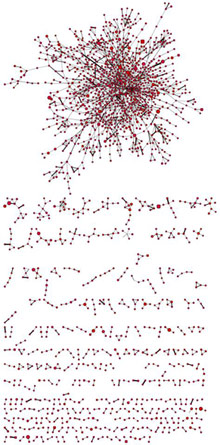Mobile carriers might get marketing insights from studying whom you call and what device you use.

Web connections: Social networks of iPhone users in late 2007 are shown in this diagram. It illustrates that many are socially connected to only a few fellow iPhone users
Each time you make a cell-phone call, your network provider knows whom you're calling, for how long, and what device you're using. Now researchers at one of the world's largest wireless carriers are exploring whether such information can help companies target their marketing pitches.
By analyzing billions of call records, the researchers at Telenor, a carrier in Scandinavia, mapped how social connections between people--measured partly by how often they called each other--correlated with the spread of Apple's iPhone after its 2007 debut. The research showed that socially connected groups of early adopters helped the iPhone spread rapidly. A person with just one iPhone-owning friend was three times more likely to own one themselves than a person whose friends had no iPhones. People with two friends who had iPhones were more than five times as likely to have sprung for the Apple device.
Now Telenor's team wants to translate insights like that into marketing campaigns. For instance, a company might send promotional text messages or ads to people whose friends already use a product--and who would presumably be more likely to buy the product as well.
"Marketing strategies based on this kind of analysis would be both useful and powerful compared to conventional ones," says Pal Sundsoy, one of the Telenor researchers. They collaborated with Rich Ling at the IT University of Copenhagen, Denmark, and will present their work at the International Conference on Advances in Social Networks Analysis and Mining next month.
They tracked the iPhone's spread using Telenor's database of CDRs--call detail records. A CDR is generated by every voice or text-message connection. Among other things, it contains the origin and destination number, the duration of a connection, and the unique mobile equipment identifier of the caller's handset. And rather than merely counting the growing number of iPhone users over time, the Telenor researchers performed what is known as social-network analysis. They examined the strength of the links between people by examining the number and duration of their calls and text messages.
Not only did they find that the spread of iPhones was greatly influenced by social circles, but also that this pattern differed from the way other devices and services rippled through the customer base. For instance, other Telenor products, including the Doro, a simple handset generally marketed at the elderly, did not exhibit the same kind of network effects. Neither did a video-calling feature introduced by Telenor in 2007. The video-calling service grew in popularity at first but suffered after a new pricing model was introduced.

Model image: This diagram shows the evolution of the largest network of Telenor iPhone users over time. Each node represents one subscriber, and its color indicates the model used. In this case, red equals 2G, green means 3G, and yellow means 3GS.
Cell-phone networks have some of the best data for developing such ideas about how to target marketing campaigns, says Cristophe Van den Bulte, an associate professor of marketing at the Wharton School of the University of Pennsylvania who uses social-network analysis to study the diffusion of products.
"They have clean, relevant data because people don't make calls to just anyone," he explains. "Other network connections can be close to meaningless--for example, my relationships with my Facebook friends."
One possible avenue for further research would be to identify which people are most able to persuade their connections to adopt a new product, Van den Bulte says. He has tried to study such patterns in the way doctors choose medical products. Alternatively, instead of trying to find trendsetters, he says, "you may actually want to target people connected to others that are easy to influence. That's an approach that needs to be looked at more."
Privacy regulations could be an obstacle. The Telenor data had to be "anonymized," or stripped of identifying information, before the researchers could use it. Privacy law in Europe in particular could make it hard, Van den Bulte says, for wireless companies there to sell marketing insights based on social-network analysis to other companies.
MIT Technology Review
No hay comentarios:
Publicar un comentario